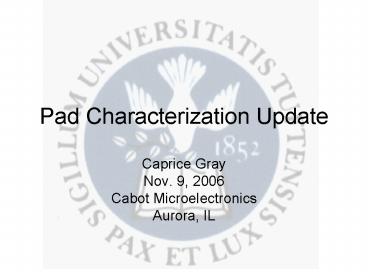Pad Characterization Update - PowerPoint PPT Presentation
1 / 18
Title:
Pad Characterization Update
Description:
Review where we were last time. Non ... Replace poor quality optical filters with high quality filters ... Accurate depth measurements or minimize chatter? ... – PowerPoint PPT presentation
Number of Views:51
Avg rating:3.0/5.0
Title: Pad Characterization Update
1
Pad Characterization Update
- Caprice Gray
- Nov. 9, 2006
- Cabot Microelectronics
- Aurora, IL
2
Outline
- Review where we were last time
- Non-DELIF imaging
- DELIF Contact detection feasibility and
preliminary results - Thesis Outline
- DELIF Modeling
- Experimental Outline
- Questions/Issue that should be resolved before
proceeding forward
3
Last Meeting Accomplishments
- Set up beam splitter aligner
- Replace poor quality optical filters with high
quality filters - Determined the source of ratio drift by modeling
intensity sources for each camera
4
Source of Ratio Drift
Calibration for all previous data sets that show
ratio drift.
All Components the cameras actually measure
Primary Source of ratio drift
Experimentally Determined Constants
New Ratio Calculation
Determined by drift
5
Imaging Benchmarks SEM
- Imaged in 3 regions of a used pad
- Edge of wafer track (most glazed region)
- Outside Wafer track (no glazing)
- Center of wafer track (less glazing)
6
Imaging Benchmarks SEM
Edge of wafer track
Center of wafer track
Outside of wafer track
In a groove Center of wafer track
7
Imaging Benchmarks SEM
- depth
SEM Image
Highest Quality DELIF
8
Imaging Benchmarks Confocal Microscopy
Similar to DELIF Resolution (scale bar 160 mm)
Zoomed image of a pore, a cross section near the
pad surface (scale bar 40 mm)
9
Imaging Benchmarks Confocal Microscopy
- 24 images are taken every 2 mm
- Video start at the deepest layer and progresses
to the surface
10
Rohm and Haas Pad-Wafer Contact Study
- Confocal Reflectance Interference Contrast
Microscopy - Images are taken through sapphire.
- No slurry
- Static
- Imaging region lt 1 mm2
- Asperity Contact 50 mm2
- Pads studied
- IC1000
- VP3000
- Politex
- Experimental
- Tested 0-6 psi, contact 0-6, experimental
contact 20
11
DELIF for Contact
- 360,000 pixels ? 2 7200 pixels
- 50 mm2 7-8 pixels (6.7 mm2/pixel)
- Focus must be really good
- We are at the resolution limit for our system
- At this resolution, we are seeing contact region
intensity smoothing
Data for static DELIF on CMC D100
12
CMC D100 Imaging Issues
- Experiment 50 consecutive static images
- Image drift correction was nearly 100 of signal
- Focus is difficult because RagtDOF
- Must carefully focus at tops of pixels
- Out of focus light bleeds into pixels that are in
focus
13
CMC D100 Imaging Issues
FX9 Emission
D100 Emission
14
Thesis Outline
In-Situ Detection of Pad/Wafer Contact with DELIF
during CMP
- Introduction
- Why are we looking for pad-wafer contact in CMP
- Literature review of experimental pad-wafer
contact measurements - Project Goal detect in-situ pad-wafer contact
- Methods
- What is DELIF, and why use it
- System model and calibration techniques
- Hardware description
- System limitations
- Image Acquisition and Processing
15
Thesis Outline
- Experimental Outline
- Description of variables and responses
- Post acquisition image interpretation (histogram
analysis, etc.) - Results and Discussion
- Comparison on contact on hard vs. soft pads
- Static measurements vs. dynamic measurements
- Pressure variation effect on contact
- Relate results to previously studied pad-wafer
contact measurements - Conclusions
- Summary of Experimental results
- Contribution of results to current understanding
of CMP - Could this technique be expanded to study
multiple polishing pad types?
16
DELIF Modeling
- Goals
- Examine how comparable our actual system is to
current DELIF models - Verify our linear calibration technique (Ratio
Intensity ? Fluid layer thickness) - Results
- slurry particles ? quadratic calibration
- As slurry particle concentration ? 0, calibration
? linear
Old Model
Current System
17
Experimental Outline
- Finish Tweaking Optics to get repeatable static
data - Identify 2 types of polishing pads that will work
optically with our system. - Similar Ra 4-6 mm
- High and Low bulk modulus
- Proceed to DOE
- Possible Variables pressure, pad/wafer velocity,
pad type, slurry dilution, pH - Responses Contact area , Contact area size,
friction signature?
18
Open Questions
- Which 2 pads should I focus my study on and will
I have a steady supply of them? - Does slurry dilution matter?
- Accurate depth measurements or minimize chatter?
- Should I continue to search for a static contact
measurement benchmarking technique, or just use
(the limited) data from literature? - Which experimental variables should I concentrate
on? - My variable preferences pad modulus, pad-wafer
speed, down-force































